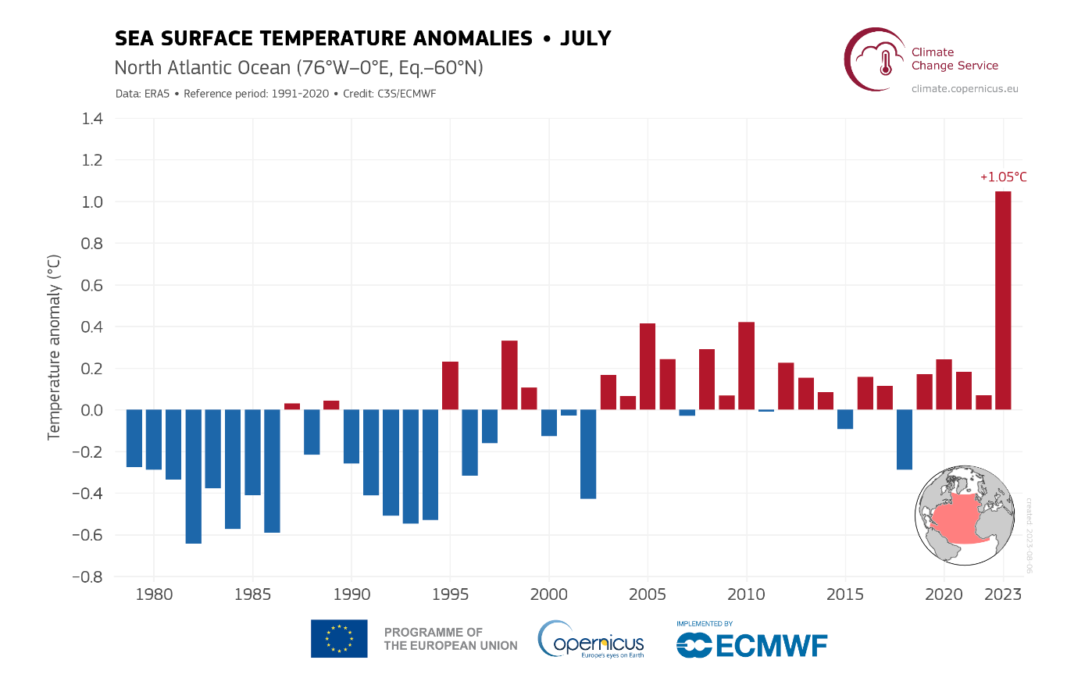Unprecedented climate records in 2024 portray warming worlds and marine heatwaves.
In the year 2024, our world finds itself at a critical juncture, confronting an unprecedented climate crisis that defies the bounds of imagination. It is a year when the relentless forces of nature, driven by the warming climate, have broken longstanding records, leaving an indelible mark on our planet. From scorching temperatures to raging wildfires, and the vanishing ice of Antarctica, the signs of climate change are unmistakable and urgent.
Table of Contents
Unprecedented Climate Records
The summer of 2024 will be etched into history as the hottest ever recorded. A joint report from the European Union’s Copernicus Climate Change Service (C3S) and the World Meteorological Organization (WMO) reveals that the three-month period from June to August saw an average temperature of 16.77 degrees Celsius. This was a remarkable 0.66 degrees Celsius above the 1990-2020 average, shattering previous records. August, in particular, set a scorching pace, with an average temperature of 16.82 degrees Celsius, surpassing the 1991-2020 average by 0.71 degrees Celsius.
In July, the world witnessed an extraordinary event as the global average daily temperature soared past 17 degrees Celsius for the first time. On July 6, the mercury reached a searing 17.08 degrees Celsius, making it the hottest day ever recorded on our planet.

The Implications: A Warming World
The implications of this heatwave are profound. With such soaring temperatures and the emergence of El Niño conditions, 2024 could potentially become the warmest year on record, trailing only 0.01 degrees Celsius behind the all-time high of 2016. This progression edges us closer to the critical 1.5 degrees Celsius above pre-industrial levels, beyond which lies the specter of irrevocable damage to our Earth’s ecosystems, with profound implications for all life on Earth.
Oceans in Climate Crisis
Simultaneously, our oceans are experiencing alarming changes. Global average sea surface temperatures (SSTs) have been on a relentless rise, breaking records along the way. In April through July 2024, SSTs consistently remained at historically high levels, culminating in the largest SST anomaly for any July on record.
According to the C3S, the peak was reached on July 31, with SSTs reaching 20.96°C, marginally exceeding the previous record from March 2016 by 0.01 degrees Celsius. Moreover, this year saw an unprecedented SST anomaly for July, with the monthly average SST hitting 20.89°C, a level previously seen only in March 2016. The anomaly stands at 0.51°C, marking the hottest July ever recorded.
The Oceanic Impact: Heatwaves and Consequences
The ramifications of these soaring sea surface temperatures extend far beyond the coastlines. Elevated SSTs, coinciding with the onset of El Niño, have far-reaching implications for global warming. While El Niño patterns are known to bring warmer SSTs to the tropical Pacific, high SSTs beyond this region, notably in the North Atlantic, are playing a significant role in global temperature trends.
Marine Heatwaves: Nature’s Response
The surge in SSTs has given birth to marine heatwaves, prolonged periods of excessively high ocean temperatures. These events wreak havoc on marine ecosystems and biodiversity, with socio-economic repercussions affecting industries such as fisheries, aquaculture, and tourism.
In June, the northeastern Atlantic grappled with multiple marine heatwaves, impacting regions around Ireland, the United Kingdom, and the Baltic Sea. While some relief was found in the first half of July, a severe (category 3) marine heatwave, extending from south of Greenland to the Labrador Sea, emerged in the northwestern Atlantic. The Caribbean Basin experienced rising temperatures from April to July, with Southern Florida facing record-breaking warmth, endangering coral reefs and sensitive marine ecosystems.

The Mediterranean Crisis: Extreme Heatwaves
July witnessed the development of a strong to severe (category 2-3) and, in some areas, extreme (category 4) marine heatwave in the Mediterranean Sea. SST anomalies of up to 3°C were observed in many Mediterranean regions, with local anomalies peaking at 5.5°C along the coasts of Italy, Greece, and North Africa. These exceptional SSTs were closely linked to the recent ‘heat dome’ and extreme heatwaves impacting Southern Europe.
The records of 2024 are more than statistics; they are stark reminders of the unfolding climate crisis. Climate change is no longer a distant threat; it is a current and urgent reality that demands immediate attention. Rising temperatures, warming oceans, and melting ice are no longer abstract concepts; they are tangible experiences.
COP26: Global Climate Commitments
The records of 2024 are more than statistics; they are stark reminders of the unfolding climate crisis. Climate change is no longer a distant threat; it is a current and urgent reality that demands immediate attention. Rising temperatures, warming oceans, and melting ice are no longer abstract concepts; they are tangible experiences.
Climate change is not an isolated issue; it is a global challenge that reverberates through ecosystems, economies, and daily lives. Marine heatwaves disrupt marine ecosystems, posing threats to fisheries, aquaculture, and tourism industries.
At the COP26 conference in Glasgow, Scotland, world leaders came together to address the pressing climate crisis. Agreements and commitments were made to accelerate efforts to reduce greenhouse gas emissions and limit global warming. These agreements include targets to achieve net-zero emissions by mid-century, provide assistance to developing nations in coping with climate impacts, and enhance global cooperation on climate action. COP26 was a pivotal moment in the global response to climate change, emphasizing the urgency of collective action.
2024 serves as a compelling call to action. These records are not mere numbers; they are wake-up calls for humanity. Nations and individuals alike must redouble efforts to reduce greenhouse gas emissions, transition to clean energy sources, and safeguard vulnerable communities. The climate crisis is not solely an environmental issue; it is the defining challenge of our time. The time to act is now, for the climate crisis is not just about the environment; it is about the future of humanity.
In the face of unprecedented climate extremes, global cooperation and immediate action are our best hope to mitigate the crisis and protect the planet for future generations. We must heed the lessons of 2024 and work tirelessly to secure a sustainable and resilient future for all.













